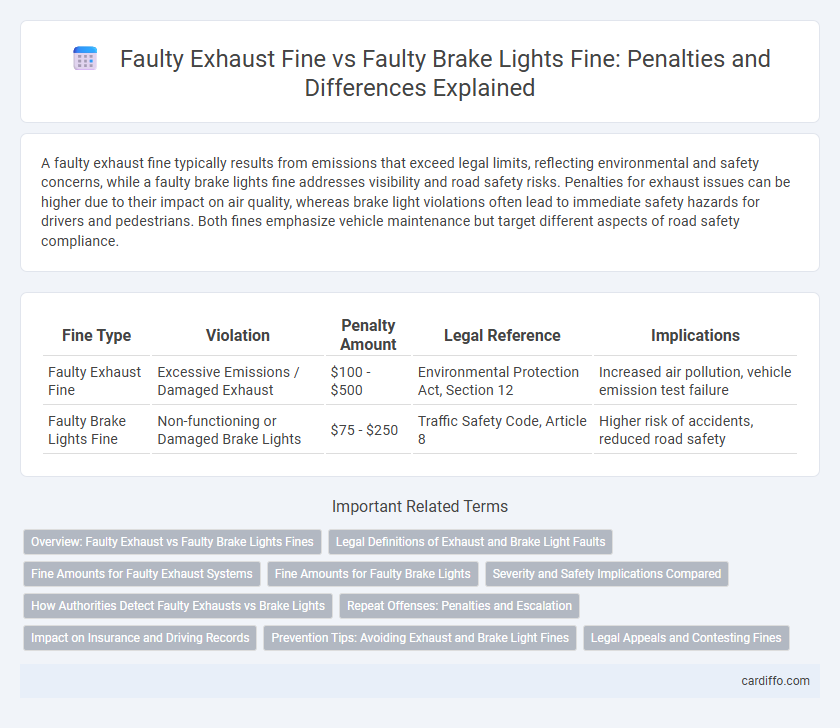A faulty exhaust fine typically results from emissions that exceed legal limits, reflecting environmental and safety concerns, while a faulty brake lights fine addresses visibility and road safety risks. Penalties for exhaust issues can be higher due to their impact on air quality, whereas brake light violations often lead to immediate safety hazards for drivers and pedestrians. Both fines emphasize vehicle maintenance but target different aspects of road safety compliance.
Table of Comparison
| Fine Type | Violation | Penalty Amount | Legal Reference | Implications |
|---|---|---|---|---|
| Faulty Exhaust Fine | Excessive Emissions / Damaged Exhaust | $100 - $500 | Environmental Protection Act, Section 12 | Increased air pollution, vehicle emission test failure |
| Faulty Brake Lights Fine | Non-functioning or Damaged Brake Lights | $75 - $250 | Traffic Safety Code, Article 8 | Higher risk of accidents, reduced road safety |
Overview: Faulty Exhaust vs Faulty Brake Lights Fines
Faulty exhaust fines typically result from vehicle emissions exceeding legal limits, with penalties often ranging between $100 to $300 depending on jurisdiction and severity. In contrast, faulty brake lights fines are usually issued for safety violations, carrying fines from $50 to $150, reflecting the critical role of brake lights in preventing accidents. Enforcement agencies prioritize brake light compliance due to direct safety impacts, while exhaust fines target environmental compliance and pollution control.
Legal Definitions of Exhaust and Brake Light Faults
Legal definitions of faulty exhaust systems typically encompass excessive emissions, loud noise violations, and non-compliance with environmental standards set by regional authorities. Faulty brake light regulations emphasize malfunctioning, non-illuminating, or improperly installed brake lights, which compromise vehicle signaling and safety. Penalties vary but generally reflect the severity of the safety or environmental risk posed by each type of fault.
Fine Amounts for Faulty Exhaust Systems
Fine amounts for faulty exhaust systems typically range from $100 to $500 depending on jurisdiction and severity of the violation. In comparison, fines for faulty brake lights usually fall between $50 and $200, reflecting a generally lower penalty for this issue. Enforcement agencies prioritize costly penalties for exhaust system failures due to their impact on environmental pollution and vehicle emissions compliance.
Fine Amounts for Faulty Brake Lights
Fines for faulty brake lights typically range from $50 to $200, depending on the jurisdiction and severity of the violation. In comparison, faulty exhaust fines can vary widely, often between $100 and $500, due to potential environmental regulations. Ensuring brake lights are fully functional is crucial to avoid the lower but still significant fines associated with brake light violations.
Severity and Safety Implications Compared
Faulty brake lights fines typically carry higher penalties due to the direct safety risk they pose by impairing vehicle signaling, increasing the likelihood of rear-end collisions. Faulty exhaust fines, while serious for environmental and health reasons, generally involve less immediate danger to road safety and often result in lower monetary penalties. The severity of brake light faults is prioritized because they directly affect accident prevention, whereas exhaust issues are more focused on pollution control and long-term health impacts.
How Authorities Detect Faulty Exhausts vs Brake Lights
Authorities detect faulty exhausts primarily through roadside emissions testing and noise level assessments using specialized equipment such as gas analyzers and decibel meters. Faulty brake lights are usually identified during vehicle inspections, traffic stops, or by observing brake light malfunctions through cameras and direct visual checks. Both detection methods rely on regulatory standards to ensure vehicle safety and environmental compliance.
Repeat Offenses: Penalties and Escalation
Repeat offenses of faulty exhaust system violations result in escalating fines and possible vehicle impoundment under most traffic laws. Similarly, repeated failure to maintain functional brake lights leads to increased penalties, including higher fines and potential driver's license suspension. Enforcement agencies prioritize these violations due to their direct impact on road safety, making penalties progressively severe with each recurrence.
Impact on Insurance and Driving Records
A faulty exhaust fine and a faulty brake lights fine both affect insurance premiums and driving records, but the impact varies by severity and safety risk. Insurance companies may increase rates more for faulty brake lights violations due to their direct influence on road safety and accident likelihood. Faulty exhaust fines typically result in lower premium hikes but can still contribute to cumulative negative marks on driving records over time.
Prevention Tips: Avoiding Exhaust and Brake Light Fines
Regularly inspecting your vehicle's exhaust system and brake lights prevents costly fines and ensures compliance with road safety regulations. Replacing worn-out brake bulbs promptly and scheduling routine emissions tests maintain optimal functionality and reduce the risk of faulty exhaust or brake light violations. Using certified parts and consulting professional mechanics can further enhance vehicle safety and legal adherence.
Legal Appeals and Contesting Fines
Contesting fines for faulty exhaust and faulty brake lights involves understanding specific legal grounds such as procedural errors, lack of proper evidence, or disproving the vehicle defect at the time of citation. Legal appeals often require submitting evidence like repair receipts, vehicle inspection reports, or expert testimony to challenge the validity of the fine. Courts may consider factors like the severity of the violation, compliance history, and promptness in addressing the fault when deciding on the appeal outcome.
Faulty Exhaust Fine vs Faulty Brake Lights Fine Infographic

 cardiffo.com
cardiffo.com